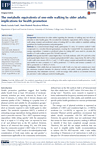Background
Instructions for older adults regarding the intensity of walking may not elicit an intensity to infer health gains. We recorded the metabolic equivalents (METs) during a 1-mile walk using constant and predicted values of resting MET in older adults to establish walking guidelines for health promotion and participation.
Methods
In a cross-sectional design study, participants (15 men, 10 women) walked 1-mile overground, in a wooden floored gymnasium, wearing the Cosmed K4b2 for measurement of energy expenditure. Constant or predicted values for resting MET were used to calculate the number of 1-mile walks to meet 450-750 MET∙min∙wk-1.
Results
Participants had MET values higher than 3 for both methods, with 29% and 64% of the participants higher than 6 for a constant and predicted MET value, respectively. The METs of the 1-mile walk were (mean±SD) 6±1 and 7±1 METs using constant and predicted resting MET, and similar for men (constant: 6±1 METs; predicted: 7±1 METs) and women (constant: 5±1 METs; predicted: 6±1 METs) (P>0.05).
Conclusion
Older adults that are instructed to walk 1-mile at a fast and constant pace meet the minimum required intensity for physical activity, and public health guidelines. Health professionals, that administer exercise, could encourage older adults to accumulate between six and nine 1-mile walks per week for health gains.



Responses